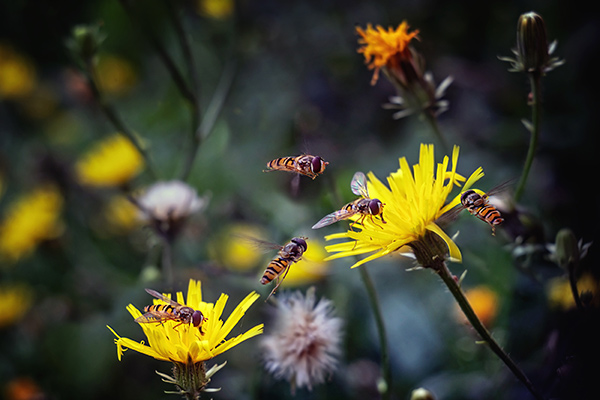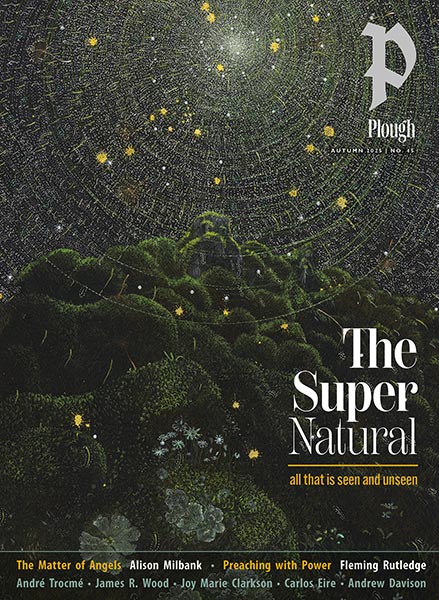Subtotal: $
Checkout
Hoverfly Heaven
Britain’s hedges are home to a remarkable and important insect.
By Christopher Hart
April 23, 2024
Christopher Hart became enthusiastic about traditional British hedges after working with friends on a nature conservation project. As he writes, “If we set out tomorrow to devise some ingenious new form of human-made habitat for our hard-pressed wildlife, we would never equal the wonders of the good old British hedge.” The following excerpt is from his new book Hedgelands: A Wild Wander around Britain’s Greatest Habitat.
Few insects are quite as beneficial in farmland, in orchards and in gardens as the amazing 120-wingbeats-per-second, 3.5-meter-per-second hoverfly. (The biting, blood-sucking horsefly, for comparison, can cover four meters per second, or about nine miles per hour; you’re going to have run quite fast to get away from a determined one. And a hornet can do thirteen miles per hour; just so you know.)
Dead trees with pools of rainwater trapped between the boughs – or indeed pollards – may produce “rot cavities” or “hoverfly lagoons”: high-rise breeding grounds for the very common hoverfly Myathropa florea, which produces a rather extraordinary-looking rat-tailed larva, the “tail” actually being a long tube to allow it to breathe underwater in those rain-filled cavities. The hoverfly is also popularly known as the Batman hoverfly, because the pattern on its thorax roughly resembles Batman’s mask.
Plants that can especially attract some of our roster of 276 native species of hoverfly include both yarrow and hogweed, both of which might be found in a well-tended grassy margin or hedgerow and therefore provide huge benefits. Indeed, they may be more important even than bees as global pollinators. Hoverflies pollinate at least 72 percent of all food crops worldwide, they transport pollen over wide distances, including the four billion or so hoverflies that migrate into the United Kingdom every springtime from the Continent – and even more will then migrate back to the Continent in the autumn.

Hoverflies on meadow flowers, agephotography/Adobestock. Used by permission.
In another experiment, strawberries pollinated by insects like hoverflies and those only self-pollinated or pollinated by the wind were photographed and compared. “Only the insect-pollinated strawberry appears recognizable as a strawberry – the other two are so shrunken and misshapen they look like someone has gnawed away most of the plump fruit and tossed the remnants away.”
Bees rarely forage more than two kilometers from their hive, but hoverflies cover hundreds of kilometers and migrate for thousands. They can even fly over one hundred kilometers of open water, “transporting viable pollen over long distances, thereby facilitating high levels of gene flow between plant populations that would otherwise remain unconnected. This, in turn, may have beneficial consequences for plant population health and fruit yield.”
And what sort of countryside best supports hoverflies? A complex, natural-looking countryside rather than a simplified and modernized agricultural landscape. “Woody elements such as hedgerows [my italics] are associated with increased local abundance of hoverflies and ecosystem services such as biocontrol of crop pests, especially when connected to forest.”
We have plenty of dense hedges and hoverfly-friendly umbellifers near our orchard – which grow of their own accord, of course, requiring nothing from me but to be left alone – and our fruit trees are never troubled by any explosions of pests. Some landowners also believe that dead wood can “harbor pests” that might spread to crops or infect nearby healthy trees, but again this is false: the dead wood is just as likely to harbor beneficial predators.
What sort of countryside best supports hoverflies? A complex, natural-looking countryside rather than a simplified and modernized agricultural landscape.
You shouldn’t even underestimate the importance of dead and hollow flower stems for insects, as green summer lushness turns everything to a crackly brown – and definitely don’t burn them, thereby producing yet more unwanted phosphate, not to mention deadly particulates. Dead flower stems and crispy dried-out flower heads are another generally very overlooked habitat for all kinds of insects, which may hibernate in them over winter, including micromoths, beetles and hymenoptera (the bees, wasps, ants, and sawflies). Earwigs love to live in a nice dry hollow stem, while seemingly dead burdocks, teasels, and knapweeds will be visited by goldfinches and other seed eaters long into winter. In teasel – a most statuesque plant in late summer – the pith is eaten by a tortrix moth and the seeds by a phalonidia moth.
Some insects will even partition a hollow stem, such as elder or bramble, into neat chambers, laying a single egg in each chamber, carefully provisioned in advance with a supply of pollen or nectar, and then seal up the stem again with mud, sawdust, or resin. The larva will turn into a prepupa and then doze through the winter in a diapause – suspended development – until spring.
So, leave your cuttings and rakings in sun-warmed piles in quiet corners. They don’t need burning and will bring many benefits, not least the many solitary bees that will re-emerge in springtime: a direct correlation has been proven between the abundance of solitary bees in the spring, the abundance of hawthorn berries the following autumn (the flowers having been pollinated by the bees), and the abundance of migratory thrushes like fieldfares and redwings in winter, feeding on those delicious ripened haws. None of this is remotely surprising to the keen observer of nature, of course, but it’s good to have it confirmed by science. Fieldfares and redwings will also tidy up and devour any old, slightly rotten or even half-fermented apples for you – one of the reasons why they can get so damn noisy, I suspect, like a pre-Christmas drinks party in Wetherspoons.
Excerpted from Christopher Hart’s new book Hedgelands: A Wild Wander around Britain’s Greatest Edge Habitat (Chelsea Green Publishing, April 2024).
Already a subscriber? Sign in
Try 3 months of unlimited access. Start your FREE TRIAL today. Cancel anytime.






